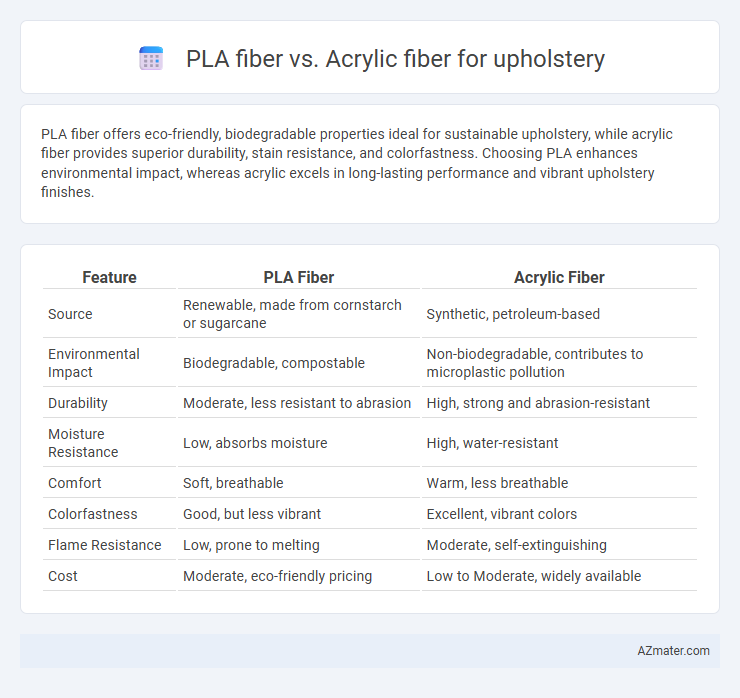PLA fiber offers eco-friendly, biodegradable properties ideal for sustainable upholstery, while acrylic fiber provides superior durability, stain resistance, and colorfastness. Choosing PLA enhances environmental impact, whereas acrylic excels in long-lasting performance and vibrant upholstery finishes.
Table of Comparison
| Feature | PLA Fiber | Acrylic Fiber |
|---|---|---|
| Source | Renewable, made from cornstarch or sugarcane | Synthetic, petroleum-based |
| Environmental Impact | Biodegradable, compostable | Non-biodegradable, contributes to microplastic pollution |
| Durability | Moderate, less resistant to abrasion | High, strong and abrasion-resistant |
| Moisture Resistance | Low, absorbs moisture | High, water-resistant |
| Comfort | Soft, breathable | Warm, less breathable |
| Colorfastness | Good, but less vibrant | Excellent, vibrant colors |
| Flame Resistance | Low, prone to melting | Moderate, self-extinguishing |
| Cost | Moderate, eco-friendly pricing | Low to Moderate, widely available |
Introduction to PLA and Acrylic Fibers in Upholstery
PLA fiber, derived from renewable resources like corn starch, offers eco-friendly advantages in upholstery with natural biodegradability and moisture-wicking properties, making it suitable for sustainable interior design. Acrylic fiber, a synthetic textile known for its durability, vibrant color retention, and resistance to mildew and fading, is widely used in upholstery for its cost-effectiveness and ease of maintenance. Both fibers present unique benefits for upholstery applications, with PLA focusing on sustainability and acrylic emphasizing long-lasting performance.
Key Properties of PLA Fiber
PLA fiber for upholstery offers exceptional biodegradability and sustainability, derived from renewable resources like corn starch, making it an eco-friendly alternative to traditional acrylic fiber. Its key properties include high tensile strength, excellent moisture-wicking capabilities, and natural resistance to UV degradation, which ensure durability and comfort in upholstery applications. Compared to acrylic fiber, PLA fiber provides superior breathability and a lower environmental impact throughout its lifecycle.
Key Properties of Acrylic Fiber
Acrylic fiber offers excellent colorfastness, resistance to sunlight, and high durability, making it ideal for upholstery in high-traffic areas. Its lightweight, soft texture provides comfort while maintaining resistance to moisture and mildew. Compared to PLA fiber, acrylic's superior UV resistance and ability to retain vibrant colors under prolonged exposure enhance its suitability for both indoor and outdoor upholstery applications.
Environmental Impact Comparison
PLA fiber, derived from renewable resources like corn starch, offers significant environmental benefits including biodegradability and lower carbon emissions during production compared to acrylic fiber. Acrylic fiber, synthesized from petroleum-based chemicals, has a higher environmental footprint due to energy-intensive manufacturing and limited biodegradability, contributing to persistent microplastic pollution. Choosing PLA fiber for upholstery supports sustainability by reducing reliance on fossil fuels and minimizing long-term ecological harm.
Durability and Longevity Differences
PLA fiber offers moderate durability for upholstery but tends to degrade faster under prolonged sunlight and moisture exposure compared to acrylic fiber. Acrylic fiber exhibits superior longevity due to its resistance to UV rays, mildew, and abrasion, making it more suitable for high-traffic furniture. The molecular structure of acrylic provides enhanced color retention and tensile strength, extending the fabric's lifespan significantly over PLA fiber in upholstery applications.
Comfort and Aesthetic Appeal
PLA fiber upholstery offers superior breathability and moisture-wicking properties, enhancing comfort in warm environments. Acrylic fiber provides vibrant color retention and a soft, wool-like texture, contributing to a visually appealing and cozy aesthetic. Combining durability with comfort, PLA suits eco-conscious interiors while acrylic excels in maintaining rich hues and plushness over time.
Maintenance and Cleaning Requirements
PLA fiber in upholstery offers natural biodegradability and resists dirt with minimal cleaning, requiring gentle hand washing or low-temperature machine cycles to maintain fiber integrity. Acrylic fiber, known for its durability and stain resistance, allows for more robust cleaning methods, including machine washing and mild chemical treatments without significant fiber damage. Maintenance of PLA demands careful moisture control to prevent degradation, whereas acrylic fibers tolerate repeated cleaning but may attract static and require anti-static treatments.
Cost Analysis: PLA vs Acrylic
PLA fiber generally costs more than acrylic fiber due to its biodegradable manufacturing process and renewable raw materials derived from corn starch or sugarcane. Acrylic fiber, produced from petroleum-based chemicals, remains more affordable, making it a budget-friendly option for upholstery projects requiring large fabric quantities. The cost difference impacts overall upholstery expenses, with PLA's environmental benefits potentially justifying its higher price in sustainable interior designs.
Best Applications for Each Fiber
PLA fiber excels in eco-friendly upholstery applications, offering biodegradability and moisture-wicking properties ideal for sustainable furniture in residential and commercial settings. Acrylic fiber is best suited for high-traffic upholstery due to its durability, resistance to fading, and ability to mimic wool's softness, making it popular in hotels, offices, and outdoor furniture. Both fibers serve distinct roles: PLA fibers prioritize sustainability and comfort, while acrylic fibers deliver long-lasting performance and vibrant color retention.
Final Verdict: Which Fiber Suits Upholstery Best?
PLA fiber offers superior sustainability with biodegradability and low environmental impact, making it an eco-friendly choice for upholstery. Acrylic fiber excels in durability, colorfastness, and resistance to moisture and UV rays, ensuring long-lasting and vibrant upholstery fabrics. For high-traffic areas demanding resilience and vivid colors, acrylic fiber suits upholstery best, while PLA fiber fits well in eco-conscious, low-use applications.

Infographic: PLA fiber vs Acrylic fiber for Upholstery
 azmater.com
azmater.com